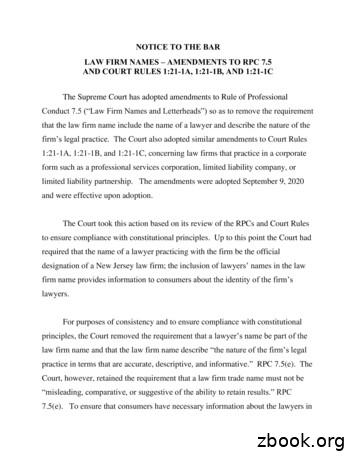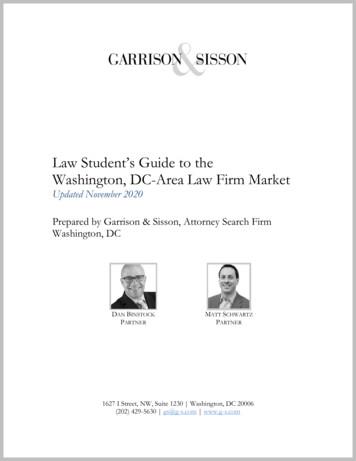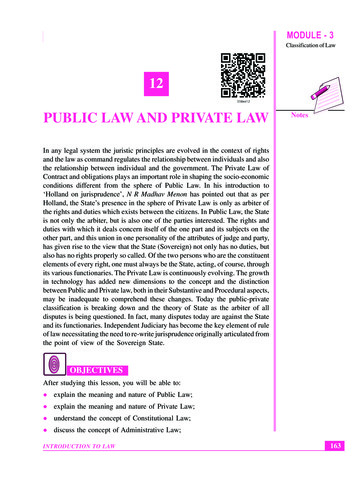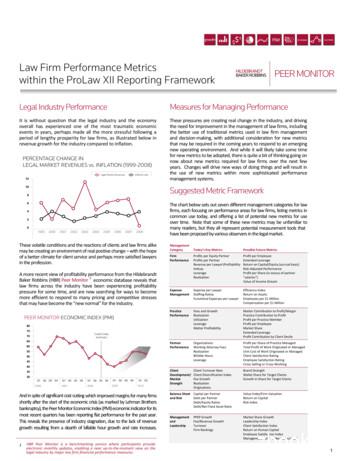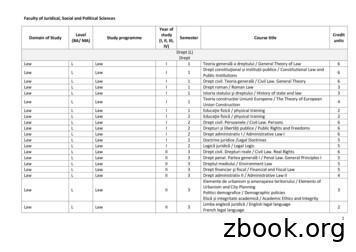NIOSH List Of Antineoplastic And Other Hazardous Drugs In .
NIOSH List of Antineoplasticand Other Hazardous Drugsin Healthcare Settings, 2016DEPARTMENT OF HEALTH AND HUMAN SERVICESCenters for Disease Control and PreventionNational Institute for Occupational Safety and Health
NIOSH List of Antineoplastic and OtherHazardous Drugs in Healthcare Settings, 2016DEPARTMENT OF HEALTH AND HUMAN SERVICESCenters for Disease Control and PreventionNational Institute for Occupational Safety and Health
This document is in the public domain and may be freely copied or reprinted.DisclaimerMention of any company or product does not constitute endorsement by the National Institute for Occupational Safety and Health (NIOSH). In addition, citations of websites external to NIOSH do not constituteNIOSH endorsement of the sponsoring organizations or their programs or products. Furthermore, NIOSHis not responsible for the content of these websites.Ordering InformationTo receive documents or other information about occupational safety and health topics, contact NIOSH atTelephone: 1-800-CDC-INFO (1-800-232-4636)TTY: 1-888-232-6348CDC-INFO: http://wwwn.cdc.gov/dcs/RequestForm.aspxor visit the NIOSH website at www.cdc.gov/niosh.For a monthly update on news at NIOSH, subscribe to NIOSH eNews by visiting www.cdc.gov/niosh/eNews.Suggested CitationNIOSH [2016]. NIOSH list of antineoplastic and other hazardous drugs in healthcare settings, 2016. ByConnor TH, MacKenzie BA, DeBord DG, Trout DB, O’Callaghan JP. Cincinnati, OH: U.S. Department ofHealth and Human Services, Centers for Disease Control and Prevention, National Institute for Occupational Safety and Health, DHHS (NIOSH) Publication Number 2016-161 (Supersedes 2014-138).NIOSH evaluation of hazardous drugs does not cover NIOSH classification of chemical carcinogens.Although NIOSH hazardous drug evaluation includes consideration of carcinogenicity and genotoxicity, this evaluation is tailored to identify and evaluate data from human toxicity profiles, animalstudies and in vitro studies unique to evaluating therapeutic agents. For example, NIOSH consults avariety of resources including, but not limited to, safety data sheets, product labeling approved by theU.S. Food and Drug Administration and databases such as DailyMed and DrugBank. For more information on NIOSH classification of chemical carcinogens see “NIOSH Chemical Carcinogen Policy,”http://www.cdc.gov/niosh/index.htm.DHHS (NIOSH) Publication No. 2016-161September 2016ii
List of AcronymsAHFSAmerican Hospital Formulary ServiceASHPAmerican Society of Health-System Pharmacists (formerly, American Societyof Hospital Pharmacy)BCGBacillus Calmette–GuérinBSCBiological safety cabinetCACICompounding aseptic containment isolatorCFRCode of Federal RegulationsCSTDClosed system drug-transfer deviceDPIDrug package insertEPAEnvironmental Protection AgencyFDAFood and Drug AdministrationHEPAHigh-efficiency particulate airHIPECHeated intraperitoneal chemotherapyIARCInternational Agency for Research on CancerIVIntravenousMRHDMaximum Recommended Human DoseMSHGManufacturer’s safe handling guidanceNIOSHNational Institute for Occupational Safety and HealthOELOccupational exposure limitOSHAOccupational Safety and Health AdministrationONSOncology Nursing SocietyPPEPersonal protective equipmentSCSubcutaneousSDSSafety Data Sheet (formerly Material Safety Data Sheet)USPUnited States Pharmacopeial Conventioniii
Preamble: The National Institute for Occupational Safety and Health (NIOSH) Alert: Preventing Occupational Exposures to Antineoplastic and Other Hazardous Drugs in HealthcareSettings was published in September 2004 (http://www.cdc.gov/niosh/docs/2004-165/). InAppendix A of the Alert, NIOSH identified a sample list of hazardous drugs. The list wascompiled from information provided by four institutions that had generated lists of hazardous drugs for their respective institutions, as well as a list from the Pharmaceutical Research and Manufacturers of America (PhRMA). The 2004 list was updated in 2010, 2012,and 2014. The current update (2016) adds 34 drugs, five of which have safe-handling recommendations from the manufacturers. In 2014, a new format was developed for the list ofhazardous drugs, as described below. The review process for the addition of the new listingsis described in the Federal Register: pdfs/233a 2015-12857.pdf.Drugs Considered HazardousI. General Approach to HandlingHazardous DrugsEarly concerns about occupational exposure toantineoplastic drugs first appeared in the 1970s.Although the antineoplastic drugs remain theprincipal focus of the Alert, other drugs may alsobe considered hazardous because they are potent(small quantities produce a physiological effect) orcause irreversible effects. As the use and numberof these potent drugs increase, so do opportunities for hazardous exposures among healthcareworkers. For example, antineoplastic drugs such ascyclophosphamide and methotrexate have provedbeneficial for treating nonmalignant diseases suchas rheumatoid arthritis and multiple sclerosis.In the Alert (NIOSH 2004) and updates to the hazardous drug list (NIOSH 2010 and 2012), NIOSHhad previously recommended standard precautions (universal precautions) be taken in handlinghazardous drugs. Given the addition of new drugformulations and drugs in tablet and/or capsuleform to the list, no single approach can cover thediverse potential occupational exposures to thedrugs. All listed drugs are considered hazardous,but safe-handling precautions can vary with theactivity and the formulation of the drug. Table 5provides some guidance on engineering controlsand personal protective equipment (PPE) that applies to all listed drugs. The current NIOSH approach involves three groups of drugs: Group 1: Antineoplastic drugs (AHFS Classifi-cation 10:00) [ASHP/AHFS DI 2016]. Note thatmany of these drugs may also pose a reproductive risk for susceptible populations (Table 1). Group 2: Non-antineoplastic drugs that meetone or more of the NIOSH criteria for a hazardous drug. Note that some of these drugs mayalso pose a reproductive risk for susceptiblepopulations (Table 2). Group 3: Drugs that primarily pose a reproduc-tive risk to men and women who are activelytrying to conceive and women who are pregnant or breast feeding, because some of thesedrugs may be present in breast milk (Table 3).1
All hazardous drugs, regardless of the formulation, should be labeled as such to prevent improperhandling. The majority of the reproductive risks associated with the drugs listed in Table 3 apply towomen, but some can apply to men only (such asreduced fertility or sperm count) or to both menand women. Although all hazardous drugs shouldbe handled according to recommended procedures, especially if they must be prepared aseptically, some populations of workers may not be atreproductive risk from handling drugs in Group 3.These include workers who are excluded from thesusceptible populations for specific reasons such asage or infertility. In addition, drugs for which themanufacturer includes safe-handling guidance inthe DPI are indicated. NIOSH carries out a hazard identification on each drug on the basis of theNIOSH criteria for a hazardous drug. No attempthas been made to perform risk assessments oneach drug or to propose exposure limits. NIOSHhas provided guidance for personal protectiveequipment and ventilated engineering controls forsome of the various scenarios in which a drug maybe handled in healthcare settings (Table 5). Thisguidance does not cover all possible situations butprovides general recommendations for the typicalhandling situations in healthcare.With the increased availability of oral antineoplasticand other hazardous drugs, additional precautionsare required in order to prevent worker exposure tothese formulations. Some drugs defined as hazardous may not pose a significant risk of direct occupational exposure because of their dosage formulation (for example, coated tablets or capsules—solid,intact medications that are administered to patientswithout modification of the formulation). However,they may pose a risk if the formulations are altered,such as by crushing tablets or making solutionsfrom them outside a ventilated cabinet [Simmons2010; Goodin et al. 2011]. Uncoated tablets maypresent a risk of exposure from dust by skin contact and/or inhalation when the tablets are counted[Shahsavarani et al. 1993; Ahmad et al. 2014]. Tabletand capsule forms of hazardous drugs should notbe placed in automated counting machines, whichsubject them to stress and may introduce powderedcontaminants into the work area [Fent et al. 2014].Counting and pouring of hazardous drugs shouldbe done carefully, and clean equipment should be2dedicated for use with these drugs. Crushing tabletsor opening capsules should be avoided and liquidformulations should be used whenever possible.During the compounding of hazardous drugs (e.g.,crushing, dissolving, or preparing a solution or anointment), workers should wear nonpermeablegowns and double gloves (Table 5). Guidelines forthe safe compounding, administration, and disposal of hazardous drugs have been developed by several organizations [NIOSH 2004; ASHP 2006; ONS2011; USP 2016, OSHA 2016]. However, the lack ofproper training for handling antineoplastic drugsin other specialty areas may be an issue that needsto be addressed [Abel 2000; Polovich and Giesker2011; Menonna-Quinn et al. 2013].II. Defining Hazardous DrugsHazardous drugs include those used for cancer chemotherapy, antiviral drugs, hormones, some bioengineered drugs, and other miscellaneous drugs.The NIOSH definition of hazardous drugs used inthe Alert is based on a definition originally developed in 1990 by the American Society of HospitalPharmacists [ASHP 1990], currently known as theAmerican Society of Health-System Pharmacists.Thus, the NIOSH definition may not accurately indicate the potential toxicity criteria associated withsome of the newer-generation pharmaceuticalsused in healthcare. For example, bioengineereddrugs target specific sites in the body, and althoughthey may or may not pose a risk to healthcare workers, some may pose a risk to patients.NIOSH and other organizations are still gathering data on the potential toxicity and health effectsrelated to highly potent drugs and bioengineereddrugs. Therefore, when working with any hazardous drug, healthcare workers should follow theapproaches described in Table 5, along with anyrecommendations included in the manufacturer’sSafety Data Sheet (SDS) or the drug package inserts(DPIs).A. ASHP Definition of Hazardous DrugsASHP defines hazardous drugs in its 1990 revisionof the Technical Assistance Bulletin on Handling
Hazardous Drugs* [ASHP 1990]. The bulletin givescriteria for identifying potentially hazardous drugsthat should be handled in accordance with an established safety program [ASHP 2006; Massoomiet al. 2008; Eisenberg 2009; ONS 2011]. The criteria are prioritized to reflect the hierarchy of potential toxicity described below. Since the hazardousdrugs covered by the Alert were designed as therapeutic agents for humans, human toxicity profilesshould be given more weight than data from animal models or in vitro systems. Additional guidance for defining hazardous drugs is available fromthe following sources: carcinogenicity [61 FedRegister 17960–18011 (1996b); IARC 2014], teratogenicity [56 Fed Register 63798–63826 (1991)],developmental toxicity [56 Fed Register 63798–63826 (1991)], and reproductive toxicity [61 FedRegister 56274–56322 (1996a)].B. NIOSH Revision of ASHP Definition1. The 1990 ASHP definition of hazardousdrugs was revised by the NIOSH WorkingGroup on Hazardous Drugs for the Alert.Drugs considered hazardous include thosethat exhibit one or more of the following sixcharacteristics in humans or animals: Carcinogenicity Teratogenicity or other developmentaltoxicity†*ASHP [1990] definition of hazardous drugs:1. Genotoxicity (i.e., mutagenicity and clastogenicity inshort-term test systems)2. Carcinogenicity in animal models, in the patientpopulation, or both, as reported by the InternationalAgency for Research on Cancer (IARC)3. Teratogenicity or fertility impairment in animal studiesor in treated patients4. Evidence of serious organ or other toxicity at low dosesin animal models or treated patients. Reproductive toxicity† Organ toxicity at low doses† Genotoxicity‡ Structure and toxicity profiles of newdrugs that mimic existing drugs determined hazardous by the above criteria2. Determining Whether a Drug is HazardousMany hazardous drugs used to treat cancer (for example, alkylating agents) bind to or damage DNA.Other antineoplastic drugs, some antivirals, antibiotics, and bioengineered drugs interfere with cellgrowth or proliferation, or with DNA synthesis. Insome cases, the nonselective actions of these drugsdisrupt the growth and function of both healthyand diseased cells, resulting in toxic side effectsfor treated patients and their offspring. These nonselective actions can also cause adverse effects inhealthcare workers who are inadvertently exposedto hazardous drugs. However, drugs other thanthose used to treat cancer may have toxic properties similar to those of the antineoplastic drugs. Forsome other drugs, adverse reproductive effects arethe primary characteristic of concern for occupational exposure. NIOSH evaluates the potential ofproposed additions to the list on the basis of theseand other characteristics of the drugs.This document presents criteria and sources of information for determining whether a drug is hazardous. When a drug has been judged to be hazardous, the various precautions outlined in the Alertshould be applied when handling that drug. Alsoincluded is a list of drugs that should be handledas hazardous. When applying the criteria for a hazardous drug as outlined above, NIOSH takes thefollowing approach.and Kirk 1988; Naumann and Sargent 1997; Sargent et al.2002]. OELs in this range are typically established for potent or toxic drugs in the pharmaceutical industry. Under allcircumstances, an evaluation of all available data should beconducted to protect healthcare workers.†All drugs have toxic side effects, but some exhibit toxicity atlow doses. The level of toxicity reflects a continuum fromrelatively nontoxic to production of toxic effects in patientsat low doses (for example, a few milligrams or less). Forexample, a daily therapeutic dose of 10 mg/day or a dose of1 mg/ kg per day in laboratory animals that produces seriousorgan toxicity, developmental toxicity, or reproductive toxicity has been used by the pharmaceutical industry to develop occupational exposure limits (OELs) of less than 10 µg/m3 after applying appropriate uncertainty factors [Sargent‡In evaluating mutagenicity for potentially hazardous drugs,responses from multiple test systems are needed before precautions can be required for handling such agents. The EPAevaluations include the type of cells affected and in vitro versus in vivo testing [51 Fed Register 34006–34012 (1986)].3
Reproductive and Developmental ToxicityNIOSH takes into account the dose for animal testing of reproductive and developmental toxicity. Ifadverse effects are observed in animal testing near,at, or below the maximum recommended humandose (MRHD), NIOSH considers it to be highly relevant. If doses producing an adverse effect are manytimes the MRHD, usually NIOSH does not considerthem in its evaluation.For reproductive and developmental effects,NIOSH notes if there was maternal toxicity, in addition to the dose. Effects on the fetus in the absence of maternal toxicity are considered relevant.Many drugs with an FDA pregnancy category Xrating meet the criteria for a hazardous drug andare listed, but each drug is evaluated individually.Similarly, for Category D, these drugs are oftenlisted because many meet the criteria for beinghazardous. Any available human data are considered significant. In June 2015, the FDA removedthe pregnancy letter categories (A, B, C, D, andX) in prescription drug labeling. The new labeling was renamed “Pregnancy,” “Lactation,” and“Females and Males of Reproductive Potential”[FDA 2015]. The plan for the new labeling is to bephased in gradually for drugs approved on or afterJune 2001, but it went into effect immediately fordrugs and biologic products submitted after June2015. Therefore, the pregnancy letter categories arestill in effect for most of the drugs described in thisdocument, for the immediate future.CarcinogenicityIn addition to dose, for carcinogenicity testingNIOSH looks for tumors in more than one speciesand sex. It looks for tumors in multiple organs andfor tumors that are not rodent-specific. Any available human data are considered significant.GenotoxicityFor effects of genotoxicity, NIOSH gives greaterweight to in vivo testing than in vitro testing. However, adverse outcomes in several in vitro tests willbe considered in its evaluation.Organ ToxicityFor organ toxicity, the low-dose criterion in thedefinition (a daily therapeutic dose of 10 mg/day or4a dose of 1 mg/kg per day in laboratory animals) isused as a benchmark.OtherDrugs with safe-handling guidelines from the manufacturer are automatically put on the list becausethe manufacturer has determined their propertieswarrant special handling.A NIOSH internal committee performs an initialreview of all new FDA drug approvals and newwarnings on existing drugs for a two-year period.Following this review, an expert panel consisting ofpeer reviewers and stakeholders reviews the proposed additions (and deletions, when applicable),using information in DrugBank, DailyMed, andthe DPIs and SDSs. Additionally, a Federal Register Notice is published requesting comments onthe proposed changes to the list. A final review ofall information is performed by NIOSH, and theupdated list is published on the NIOSH HazardousDrug Topic Page (http://www.cdc.gov/niosh/topics/hazdrug/) and in the Federal Register.In addition to using the list of hazardous drugspresented here, each organization should create itsown list of drugs considered to be hazardous, basedon drugs in its formulary. This document presentsguidance for making such a facility-specific list (seesection entitled How to Generate Your Own List ofHazardous Drugs). Subsequently, newly purchaseddrugs should be evaluated against the organization’s hazardous drug criteria and added to the listif they are deemed hazardous. Organizations havedeveloped various approaches to identifying andclassifying hazardous drugs [Chaffee et al. 2010;Badry et al. 2013; Kaestli et al. 2013]. Although theclassification schemes may differ somewhat, thedrugs listed as hazardous are quite similar.Individual organizations may not have adequateresources for determining their own list of hazardous drugs. If so, the list of hazardous drugs in thisdocument will help employers and workers to determine when precautions are needed. However, reliance on such a published list is a concern becauseit quickly becomes outdated as new drugs continually enter the market or listed drugs are removedwhen additional information becomes available.NIOSH will update this list periodically by adding
drugs that meet its criteria and removing those thatno longer meet its criteria. This hazardous drug listwill be posted on the NIOSH website at www.cdc.gov/niosh/topics/hazdrug/. In addition, drugs thathave safe-handling guidance from the manufacturers in the DPIs will be posted on this website afterthey are approved by the FDA.B. NIOSH List of Hazardous DrugsThe following list (Tables 1–3) contains those drugsthat NIOSH has reviewed according to the criteriain the NIOSH definition of a hazardous drug. Thelist was compiled from the following: the 2014 NIOSH update to the list the NIOSH 2016 update to the list, for whichIII. How to Generate Your Own Listof Hazardous DrugsA. OSHA Hazard CommunicationThe OSHA hazard communication
Health and Human Services, Centers for Disease Control and Prevention, National Institute for Occupa- tional Safety and Health, DHHS (NIOSH) Publication Number 2016-161 (Supersedes 2014-138). NIOSH evaluation of hazardous drugs does not cover NIOSH classification of chemical carcinogens.
W. Stephen Brightwell NIOSH Michael J. Colligan NIOSH Joseph J. Hurrell, Jr. NIOSH Theodore M. Katz NIOSH David E. LeGrande Communications Workers of America Nancy Lessin Massachusetts AFL-CIO Richard A. Lippin USA MEDDAC Jane A. Lipscomb University of Maryland Lawrenc
1990, 2006 ASHP Guidelines on Handling Hazardous Drugs (HDs) 2004 NIOSH Safety Alert NIOSH LIST of Antineoplastic and Other Hazardous Drugs in Healthcare Settings – most recent update 2016 (updated every 2 years) USP 797 USP 800 Fin
Jun 26, 2020 · Hazardous Drugs—Handling in Healthcare Settings to clarify that for the purposes of the chapter, the term “antineoplastic” is intended to refer to antineoplastic hazardous drugs (HDs) included in Table 1 of the most current National I
Acknowledgements: NIOSH R01 OH 011799: Predicting slips during ladder climbing: novel methods for assessing shoe-rung friction NIOSH R21 OH 010038: Quantifying the Recovery Response and Role of Hand Strength During Ladder Falls NIOSH T42 OH 008672: Effects of Hand and Foot Positions on Ladder Slip and Fall Outcomes OSHA SH-24880-13-60-F-55: Safety and Ergonomics for Renewable Energy
Journal of Occupational Safety and Health National Institute of Occupational Safety and Health (NIOSH) Ministry of Human Resources Malaysia June 2016, Vol 13, No 1 ISSN 1675-5456 PP13199/12/2012 (032005) Lot 1, Jalan 15/1, Section 15, 43650 Bandar Baru Bangi, Selangor Darul Ehsan. Tel : 03-8769 2100 Fax : 03-8926 2900 www.niosh.com.my
represent and should not be construed to represent any agency determination or policy. 8 Determining Whether a Drug Is Hazardous NIOSH uses a sequential approach for assessing and interpreting scientific information in order to determine whether an FDA-approved drug meets the NIOSH definition of hazardous drug. NIOSH's
Airborne lead is analyzed via NIOSH method 7301 and airborne fibers inclusive of asbestos is analyzed by NIOSH method 7400. NIOSH method utilizes a technique called Phase Contrast Microscopy (PCM) which can identify the presence of both asbestos and non-asbestos type fibers, with the result being the combination of the two.
Jeffery was a good introduction to scoping. In appropriate order different bureaucratic levels were tackled, always sensitive to the pressures in each place. The many discussions with Roger proved useful during the field work later. For example, we confronted the problem of finding very large sample sites which were suitable on other parameters. So we discussed how this should be tackled .













